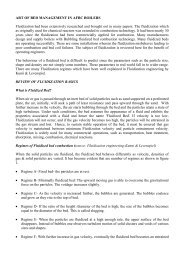Bank tube failure in a Distillery
Create successful ePaper yourself
Turn your PDF publications into a flip-book with our unique Google optimized e-Paper software.
Next Call<br />
By the time the next call came, it appeared that many more <strong>failure</strong>s had occurred. The plant had been<br />
off <strong>in</strong> between several times. The plant personnel did not follow the lay-up procedure.<br />
I was shown the corroded iron particles collected from the mud drum and bed coil <strong>in</strong>let headers. This<br />
time the boiler drums were opened. The drum surface was conta<strong>in</strong><strong>in</strong>g bubbles of iron oxide deposits.<br />
The <strong>in</strong>side of the bank <strong>tube</strong>s also conta<strong>in</strong>ed bubbles of iron oxide deposits.<br />
There were no pits <strong>in</strong> the surfaces. However below the loose iron oxide deposits pits were found to be<br />
form<strong>in</strong>g. It was clear the large amount of corrosion products did not generate from the boiler. The<br />
feedwater tank was conta<strong>in</strong><strong>in</strong>g lot of iron oxides particles. The sparger heat<strong>in</strong>g arrangement was found<br />
to be stirr<strong>in</strong>g the loose iron oxides. This proved the entry of the loose iron oxide deposits <strong>in</strong>to the<br />
boiler.<br />
Now <strong>in</strong> the boiler bank the <strong>failure</strong>s were found only <strong>in</strong> the first row of the bank <strong>tube</strong>s. Customer<br />
wanted to know why the <strong>failure</strong> could occur only <strong>in</strong> this location. The reason I could give was that the<br />
circulation of water should be m<strong>in</strong>imum here because the refractory tiles block the heat pick up <strong>in</strong><br />
these <strong>tube</strong>s. Hence the loose iron oxides could not have rema<strong>in</strong>ed <strong>in</strong> motion. Nice theory! Is it not? If<br />
it were gross pitt<strong>in</strong>g with<strong>in</strong> the boiler, not a s<strong>in</strong>gle time the bed coil or water wall or other boiler bank<br />
<strong>tube</strong>s failed. That is how I have reasoned out.<br />
CONCLUSION<br />
Now com<strong>in</strong>g to the source of problem. The pH is not boosted <strong>in</strong> water treatment plant. The low pH<br />
water was be<strong>in</strong>g pumped through the MS pip<strong>in</strong>g to the MS tank. The hydrogen could easily rip the<br />
iron from the metal surface. The craters <strong>in</strong> the tank & pip<strong>in</strong>g proved this. In the feedwater tank there<br />
was no presence of iron / iron oxides above water level or even <strong>in</strong> the roof. This proved that the pH of<br />
the water was do<strong>in</strong>g the mischief.<br />
I had recommended for SS pip<strong>in</strong>g from the storage tank to feed water storage tank <strong>in</strong> the boiler house.<br />
The pH boost<strong>in</strong>g must be done at the outlet of water treatment plant. At least two other cases I have<br />
come across where<strong>in</strong> the feed water tank consists of lot of iron oxide products.<br />
WATER LEVEL DANCING IN A BIDRUM BOILER<br />
It is a bidrum boiler where<strong>in</strong> the drum level kept danc<strong>in</strong>g. The customer had this problem s<strong>in</strong>ce<br />
<strong>in</strong>stallation. The water level nearly goes out of the gauge glass at the top tapp<strong>in</strong>g <strong>in</strong> the steam drum. It<br />
is a plant where<strong>in</strong> 80 % of the condensate comes back. The blow down pit looked reddish. The boiler<br />
drum showed off reddish stuff. S<strong>in</strong>ce it is A low-pressure boiler, there was no economizer. Otherwise<br />
the economizer could be a supply source of iron oxides. Either the oxides were form<strong>in</strong>g with<strong>in</strong> the<br />
boiler or it was gett<strong>in</strong>g transported through the condensate or make water system. First I traced down<br />
the condensate return system. There was very less chance of even oxygen gett<strong>in</strong>g <strong>in</strong> to the system. The<br />
plant runs practically thorough out the year and hence there was no chance of the iron oxides<br />
formation from the plant. But on <strong>in</strong>spection of the DM water storage tank, I saw junks of corrosion<br />
product. The pH from the DM plant was less than 7. The DM water storage tank was not l<strong>in</strong>ed with<br />
rubber or any other protection system. The pH was not be<strong>in</strong>g boosted up at the DM outlet.

















